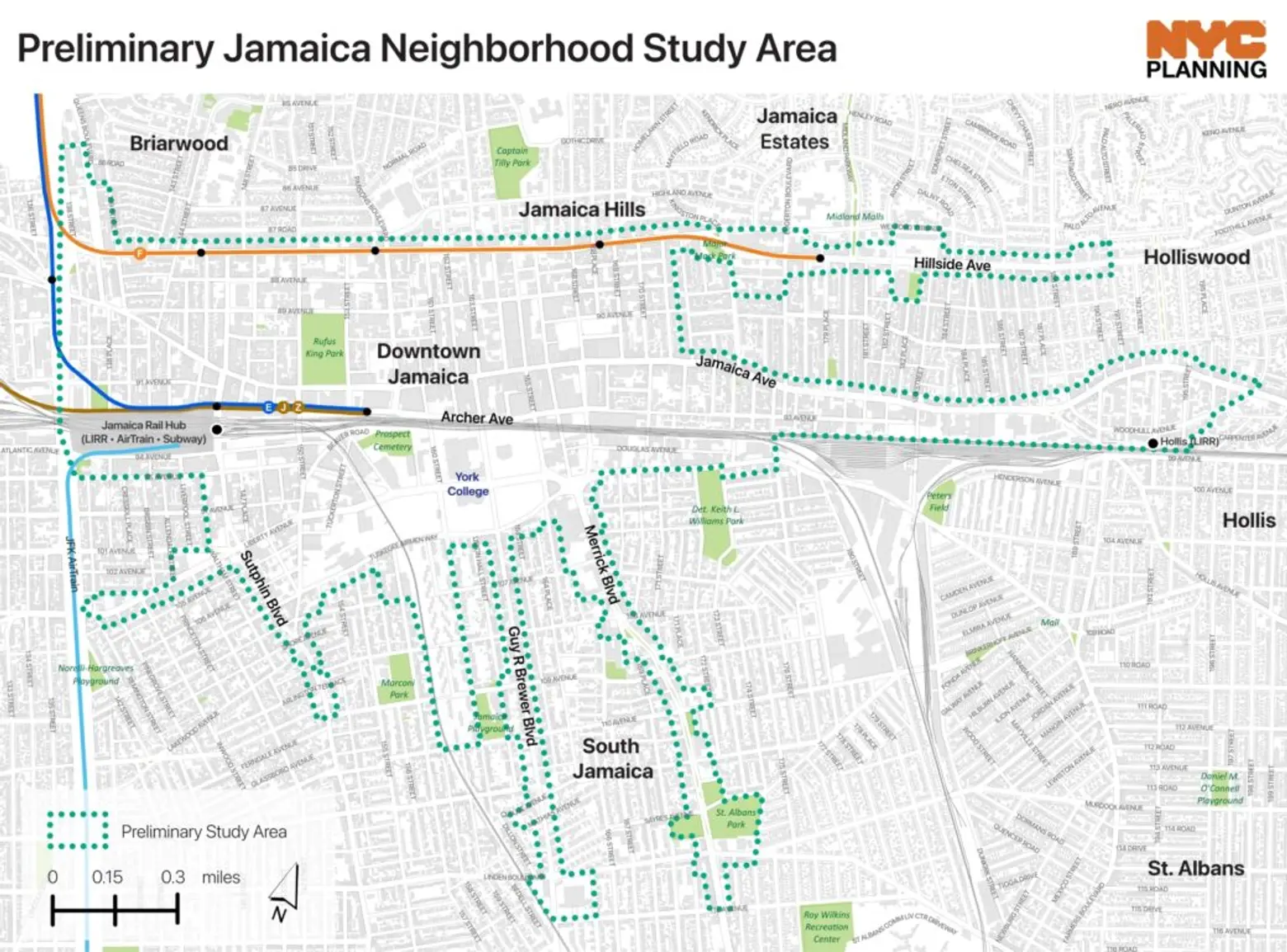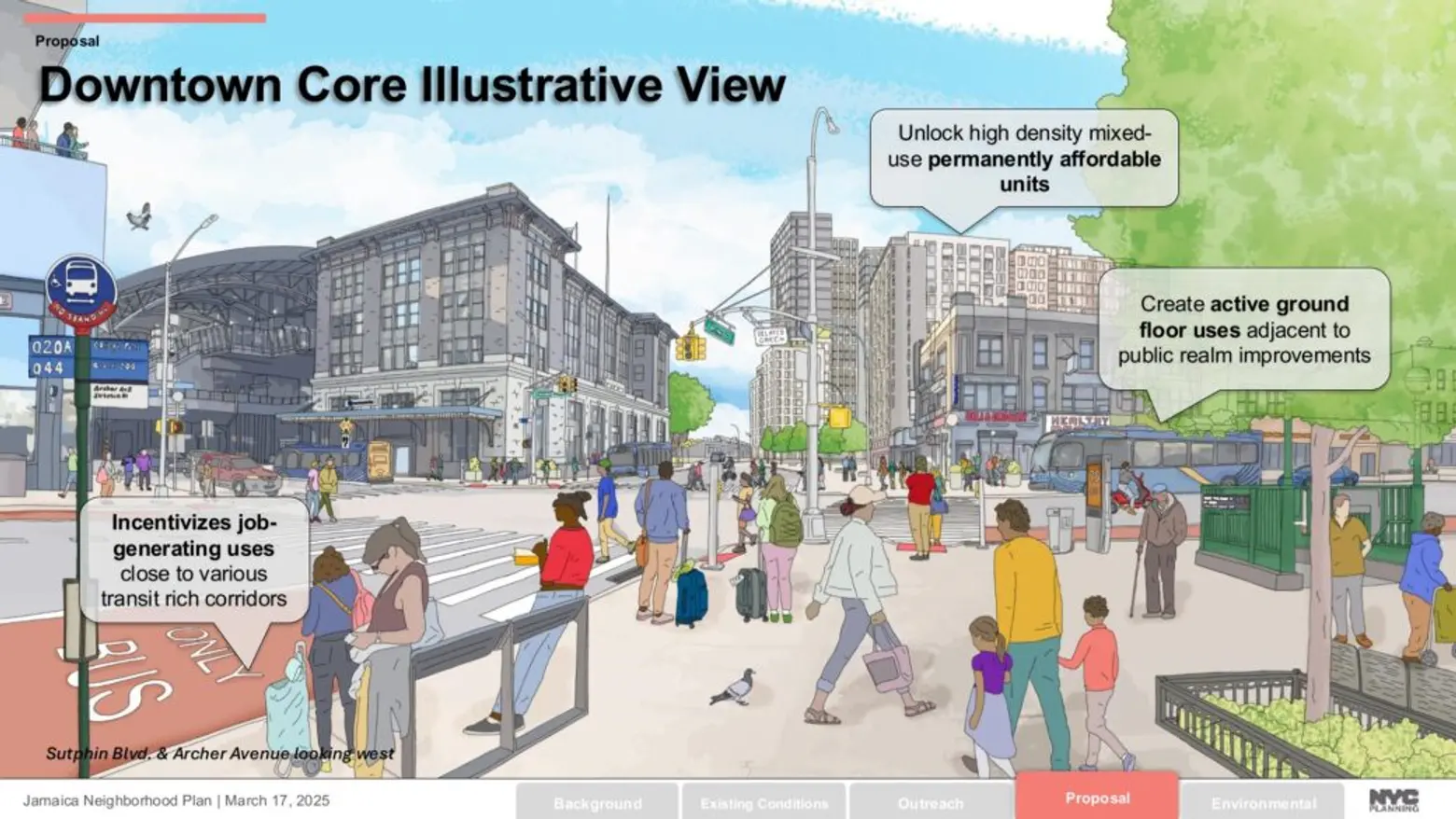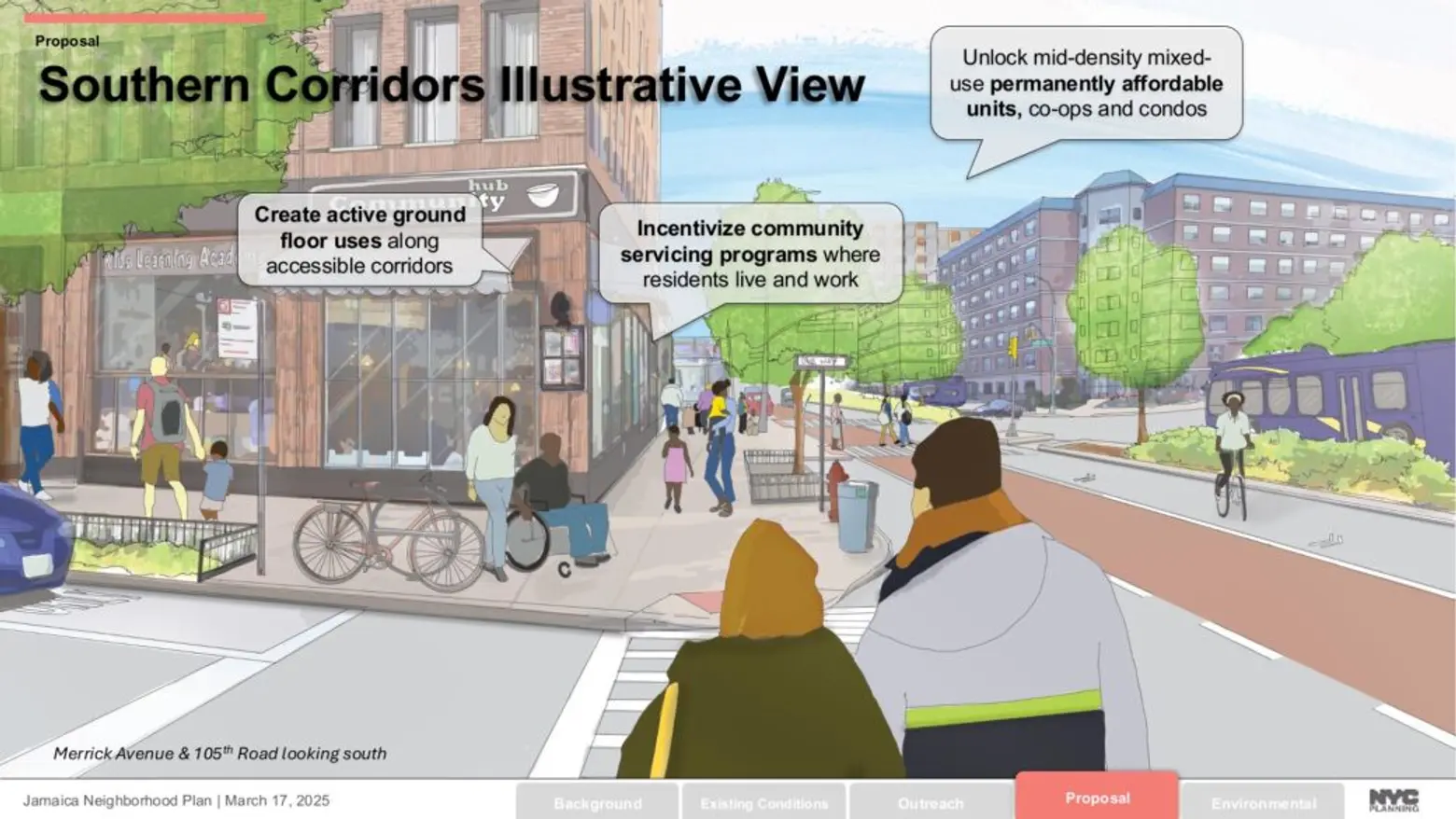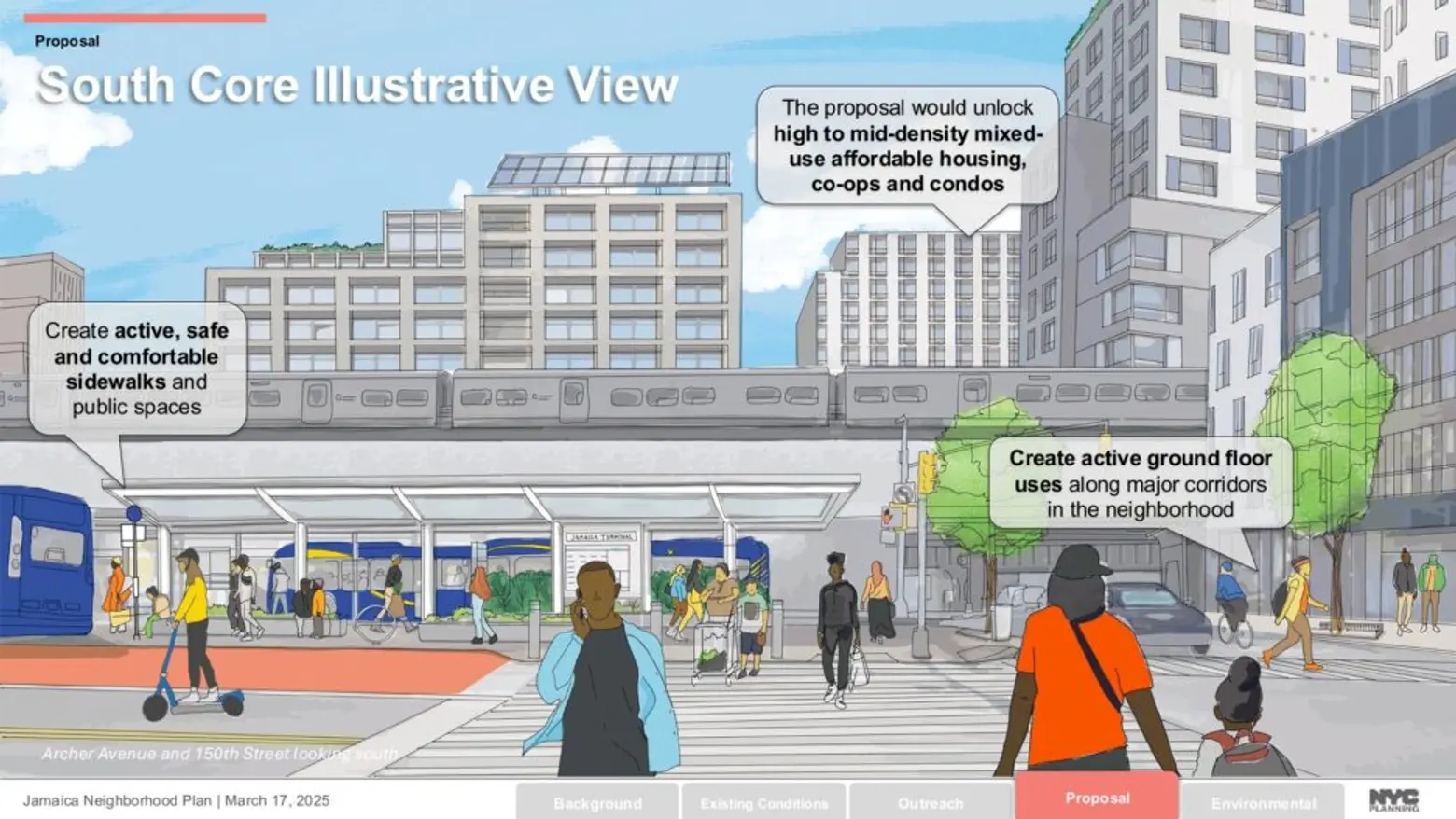
All images courtesy of DCP
Nearly 12,000 new homes are coming to downtown Jamaica, Queens, following the City Council’s approval of the neighborhood’s transformative rezoning on Wednesday. The Jamaica Neighborhood Plan updates zoning rules across 230 blocks of the transit-rich area, paving the way for thousands of new homes—roughly 4,000 of which would be permanently affordable. The plan, which includes the largest mapping of Manda…

All images courtesy of DCP
Nearly 12,000 new homes are coming to downtown Jamaica, Queens, following the City Council’s approval of the neighborhood’s transformative rezoning on Wednesday. The Jamaica Neighborhood Plan updates zoning rules across 230 blocks of the transit-rich area, paving the way for thousands of new homes—roughly 4,000 of which would be permanently affordable. The plan, which includes the largest mapping of Mandatory Inclusionary Housing (MIH) in the city, will also add two million square feet of commercial space, create more than 7,000 jobs, and deliver $400 million in infrastructure upgrades.
 Credit: DCP
Credit: DCP
The roughly 230-block rezoning area is currently made up of one- and two-family homes, multifamily residential buildings, commercial and industrial uses, and community facilities such as schools, government offices, and faith-based organizations. Surrounding blocks are largely defined by low-rise development and single- or two-family homes.
Despite serving as a commercial engine and major transit hub, the DCP says outdated zoning laws have hindered Jamaica’s growth. The current zoning laws do not require affordable housing, limit space for industrial development, and restrict Jamaica’s potential to thrive as a vibrant place to live, work, and play, as 6sqft previously reported.
“Anyone who has spent time in Jamaica knows that it’s one of the city’s most bustling hubs, but for too long, outdated zoning held it back,” Dan Garodnick, DCP director and chair, said. “Thanks to today’s vote, that will change; Jamaica will see new homes, jobs, and investments that improve life for everyone who lives, works, and spends time there.”
The rezoning aims to lift these outdated restrictions across the neighborhood, dividing it into five sub-areas: the North Core, Downtown Core, South Core, Southern Corridors, and Industrial Areas.

Spanning from Hillside Avenue to Jamaica Avenue, the North Core currently lacks housing despite its close proximity to multiple train lines. Under the rezoning, this area will be opened up for new housing developments.

The Downtown Core, which spans Jamaica Avenue and Archer Avenue, will be rezoned to permit buildings up to 18 stories and encourage high-density, mixed-use development with permanently affordable housing, active ground-floor retail, and community services. Just north, between Jamaica Avenue and Hillside Avenue, building densities would slightly decrease.

The Southern Corridors, including major streets such as Sutphin Boulevard, Guy R. Brewer Boulevard, and Merrick Boulevard, would be rezoned to allow mixed-use buildings up to 11 stories tall, an increase from the current eight-story limit, with space for local retail and community facilities.

The South Core, located just south of Jamaica Center and the Archer Avenue bus terminal, would see new housing for the first time in 60 years and create space for commercial and light manufacturing uses near the transit hub.

Finally, the Industrial Growth Area, located in the eastern section of the rezoning zone, would be updated to support and preserve existing industrial businesses while largely maintaining its industrial character.
Across the neighborhood, the rezoning would create more than two million square feet of commercial and community facility space, generating over 7,000 new jobs and strengthening Jamaica’s identity as a “live-work” community where residents can access good-paying jobs close to home. It would also provide funding for small businesses and workforce training programs to connect local business owners and workers with new economic opportunities.
The Jamaica Neighborhood Plan also allocates $315 million for upgrades to the area’s sanitary sewer infrastructure to address long-standing flooding issues as the community grows. The improvements would begin at the Jamaica Bay Wastewater Resource Recovery Facility and extend north toward downtown Jamaica.
The Department of Environmental Protection will partner with the Departments of Parks and Recreation, Transportation, and the Housing Authority to invest in green infrastructure projects across Jamaica. The city will also provide $7 million in City Council grants to help nonprofit organizations retrofit their basements to prevent flood damage.
The plan also dedicates roughly $80 million to public health infrastructure, including an expansion of NYC Health + Hospitals/Queens’ Claire Shulman Pavilion, a new Queens Neighborhood Health Action Center, and a new Trauma Recovery Center in downtown Jamaica.
Streetscape and public space improvements are also coming to the neighborhood as part of the “Jamaica NOW” plan, which is currently revamping Jamaica Avenue between Sutphin Boulevard and 168th Place with bus bulbs, curb extensions, improved lighting, green infrastructure, public art, and expanded open space.
Other transportation upgrades include the reconstruction of 165th Street as a shared corridor for pedestrians, safety improvements for pedestrians along Merrick Boulevard between Liberty Avenue and Linden Boulevard, and Vision Zero safety enhancements between Merrick Boulevard and Sutphin Boulevard.
A new bike boulevard will be added along 160th Street, and 109th Avenue between the Van Wyck Expressway and 117th Street will serve as a key connection linking parks and schools throughout the neighborhood.
The Archer Avenue Bus Terminal area—the largest bus-to-rail transfer point in North America—would receive major investments, including nearly $50 million to create two new transit plazas at Archer Avenue’s intersections with 146th Street, Sutphin Boulevard, and 147th Place. Additional park space is planned for 138th Street and the Van Wyck Expressway, as well as 142nd Street and 107th Avenue.
Educational investments include funding for capital improvements at local schools, continued development of the Queens Science, Technology, Engineering, Arts, and Mathematics Center—the first of its kind in the borough—and accessibility upgrades at York College.
The Jamaica Neighborhood Plan builds on two years of public engagement and incorporates input from residents, stakeholders, and elected officials. Outreach was guided by a steering committee of more than 50 community representatives, including elected leaders, Queens Community Boards 8 and 12, and local advocacy groups. The process generated roughly 3,000 comments through 40 in-person and virtual public meetings.
To ensure continued community involvement, the City Council, with support from the Adams administration, will establish an independent Downtown Jamaica Oversight Task Force to provide regular updates on the plan’s progress and commitments.
Council Member Nantasha Williams described the rezoning’s benefits as long overdue and emphasized the task force’s role in making sure the project serves local residents.
“With new affordable homes, jobs, and long-overdue infrastructure improvements on the way, this plan represents a real opportunity to shape the future of Jamaica in partnership with the community,” Williams said.
She added, “As we move forward, continued oversight and collaboration through the Downtown Jamaica Task Force will be key to ensuring these investments deliver lasting impact for the people who call Jamaica home.”
In March, the Department of City Planning launched the approval process for the Jamaica rezoning. Following certification, the agency released the Jamaica Neighborhood Plan booklet, outlining the proposal and detailing the planning process.
The Jamaica rezoning is among five neighborhood rezonings advanced by the Adams administration in recent years. On Thursday, the City Council approved the OneLIC Neighborhood Plan, which is expected to bring nearly 15,000 new homes, including 4,350 permanently affordable units, to a 54-block stretch of the Queens neighborhood.
Other rezonings include the Bronx-Metro North Station Area Plan, approved by the Council in August 2024, the Atlantic Avenue Mixed-Use Plan, approved in March, and the Midtown South Mixed-Use plan, approved in August.
Adams celebrated the Council’s approval of the Jamaica Neighborhood Plan, saying it would finally pave the way for new homes and jobs in the vibrant, transit-rich neighborhood.
“From bustling storefronts to busy train lines, Jamaica is exactly where our city should be building new housing and creating new jobs,” Adams said. “For too long, the neighborhood’s outdated zoning code has made it harder to do both; but today, we changed that.”
He added, “With the historic passage of our administration’s ‘Jamaica Neighborhood Plan,’ we have opened the door to thousands of new homes, thousands of new jobs, and delivered hundreds of millions of dollars for new infrastructure.
RELATED: